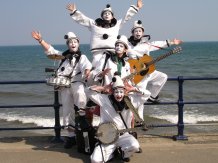Articles

The Pierrotters at Scarborough, 2008. Photograph by Lizzie Coombes (Matron)
Incredible history of one of England’s last pierrot troupes on display for the first time
For decades they were one of the country’s last remaining pierrot troupes, bringing joy to people of all ages at seaside resorts with their singing, dancing and games. Now the incredible history of The Pierrotters is on display for the first time in a new digital archive which shows their unique place in British culture.
The group, known for their acapella songs, sweet ballads and music hall routines as well as including Punch and Judy, a flea circus, comedy and circus skills in their act, helped to keep traditional beach performance skills alive during their 26-years together.
Now thousands of artefacts recording the troupe’s work and details of their act are online, along with recordings so people can enjoy their work once more.
The 4,500-item archive covers the history of the troupe from the early 1980s to 2009, via audio and television recordings, photographers, flyers, reviews in newspapers and even bank details and contracts. It also includes fan mail, scripts and publicity materials. The website has been put together by troupe member Tony Lidington, aka Uncle Tacko.
Dr Lidington became interested in pierrot performance when he was a student at Sussex University, and he started collecting pictures bought at jumble sales. He used his 21st birthday money to buy satin, which he used to make costumes, and a banjo, which he learned to play, and started busking in Brighton to make some spare money. Eventually Dr Lidington persuaded friends to join him and The Pierrotters were formed. They became a roving troupe when their application for a regular slot on the Pavilion Lawns was turned down.
Dr Lidington, now an expert in the history of popular theatre at the University of Exeter, said: “We hope this archive will be something people can enjoy now, and also use in 100 years when they look back at street theatre of this era. This recent history is already something I use when I teach outdoor performance.
“The archive is a result of 26 years of our act. I had endless files and now the contents are in chronological order for everyone to explore and enjoy. I’m a hoarder, I like history, and I kept all the items because one day I thought they would be useful to researchers such as myself in the future.
“In Britain there are not enough materials kept about the smaller shows, the performances outside of our big theatres, but this doesn’t mean they aren’t important, or haven’t had a massive impact on our culture.
“I hope this archive helps people learn more about the history of pierrot performance. It has played a big part of British culture during the past century and the art form needs more recognition. Pierrot performers are skilled in helping people of all ages to have fun, to turn a disparate group into a congregation.”
Dr Lidington, who is writing a book on pierrot history commissioned by Routledge Publishing, was able to complete the archive thanks to Arts Council emergency funding distributed because of coronavirus. The collection is chronological, with exhibits displayed for each year.
The last working troupe before The Pierrotters was known as The Ramblas, who worked in Clacton until 1964. The Pierrotters stopped performing in 2009, and since then Dr Lidington has taught students who have gone on to form their own troops for a brief time. The Pierrotters met the Queen and Duke of Edinburgh and worked at every seaside resort in the country. This summer Dr Lidington performed with his 17-year-old son Spike at seaside resorts in Devon.
Dr Lidington said: “Being a seaside performer is a hard job, you have to act, sing and dance for up to five hours each day, playing to crowds big and small.
“We started because we were broke and on the dole – so we needed to earn money and the new street entertainment scene was a means to earn cash. Our first show was to three people in the basement of a friend’s house, with 50 more faces drawn onto paper plates and perched on the bookshelves and mantelpiece.
“The first season’s set consisted of just six numbers, some of which remained in the repertoire for 26 years. We went out onto the seafront immediately after that first gig and performed for audiences wherever we found them, or where we simply felt like it might be fun.”
Date: 1 December 2020
